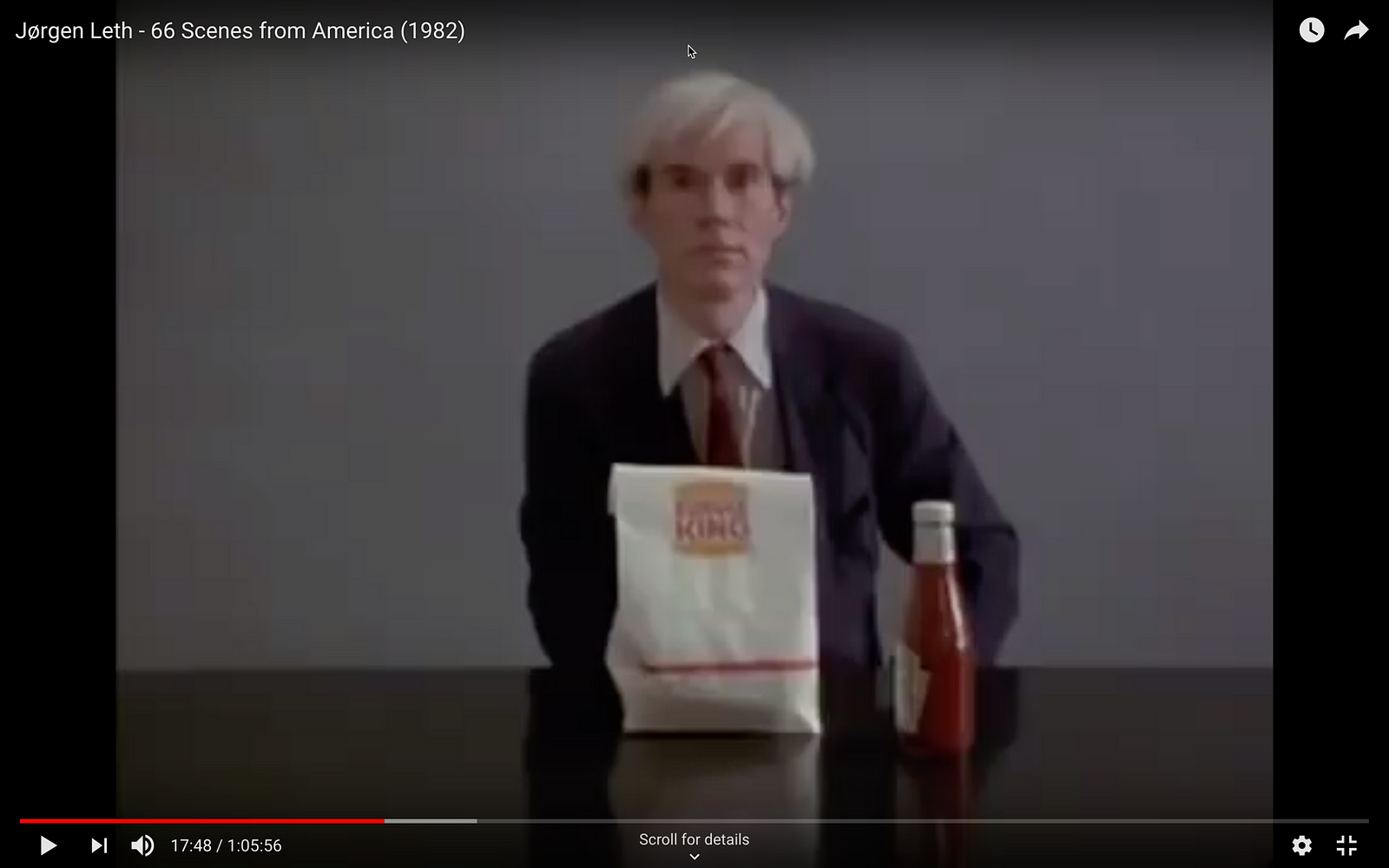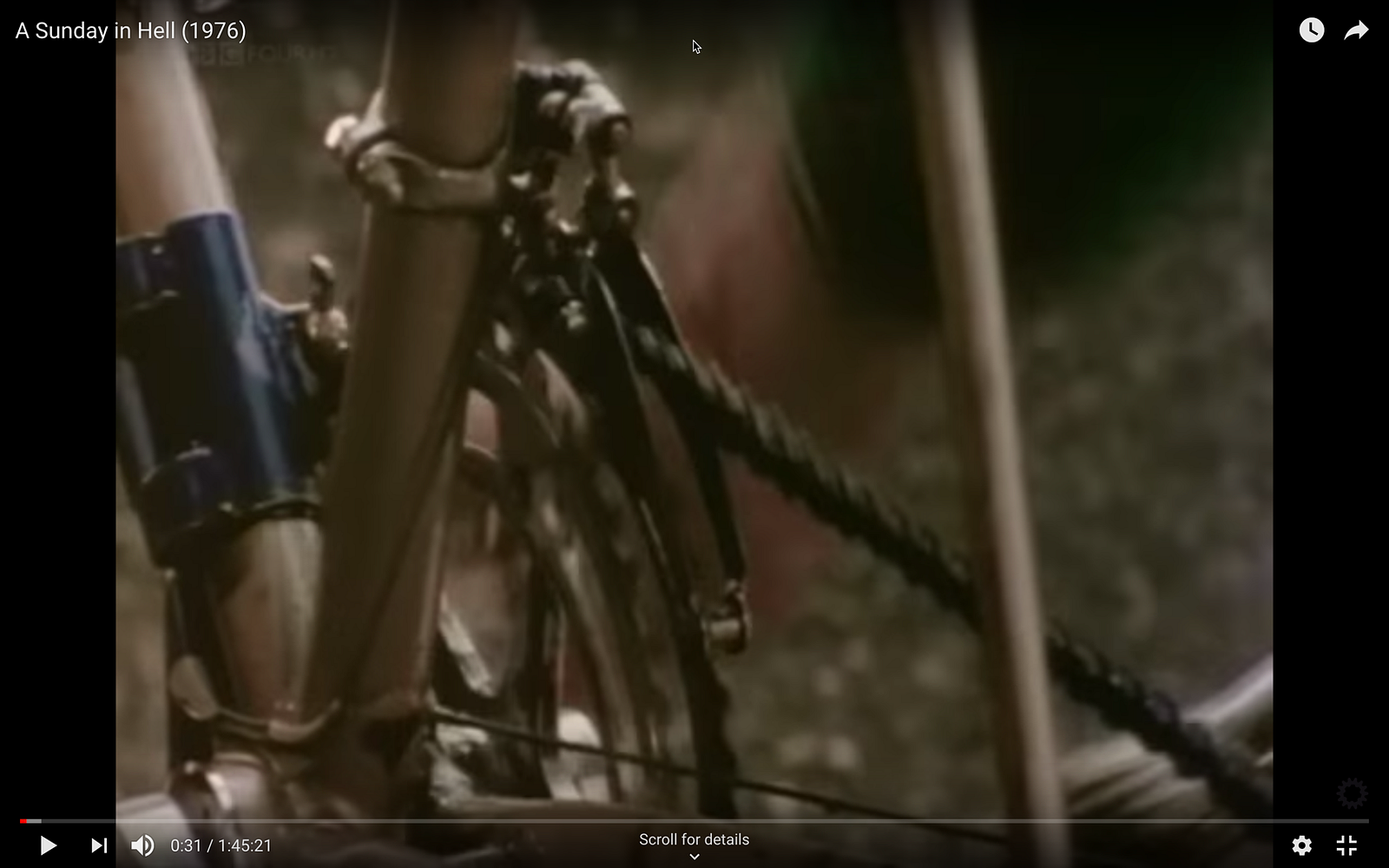 Still from Jørgen Leth — ’66 Scenes from America (1982)’
Still from Jørgen Leth — ’66 Scenes from America (1982)’
If you happened to be watching the recent 2018 Superbowl, you may’ve been as perplexed as I was to see an ad with Andy Warhol eating a Burger King Whopper. When I saw it I narrowed my eyes, wondering if I was watching a spoof — someone done up in a Warhol fright wig, or perhaps the Algorithm reached super critical and was able to create a spot-on full-motion rendering of dead people by analyzing all the footage of Warhol available in the Database.
It wasn’t until some days had passed when I noticed my hero-friend photographer @littlebrownmushroom discussing it on IG did I realize that it was, in fact, Warhol eating a burger, as shot by Jørgen Leth, a Danish filmmaker. It was from a cinematic postcard he made called “66 Scenes from America.” It’s stunning, beautiful, slow-cinema.
So, now another visual storyteller to study! Fun!
Of course, the collision of coincidences didn’t end there.
 “A Sunday In Hell” — Jørgen Leth (1977)
“A Sunday In Hell” — Jørgen Leth (1977)
On the local social Friday Randy’s Donut Ride, I was animatedly explaining this curious sequence of events to pal Rob Jonas. He then said, “Oh. Look — it’s Jørgen Leth. He directed ‘A Sunday In Hell’. You know, the film about the Paris Roubaix.” (Whose opening scene has us watch Eddy Merckx silently clean a drive chain for about 1:30, and then watch as he gets an oily leg massage for nearly 2 minutes. This nearly rivals Sergio Leone audacious 12 minutes of no dialogue that opens ‘The Good, The Bad, and The Ugly’. If you are as otaku as I am about BTS production details of films you love, there’s a BTS book soon to be released by William Fotheringham called, well, “Sunday in Hell: Behind the Lens of the Greatest Cycling Film of All Time”)
Watch both of these — “66 Scenes from America” and “A Sunday In Hell” — back to back (or even side-by-side) and you’ll notice a striking, slow-cinematic visual style. There is a lovely, non-frenetic visual aesthetic that’s compelling for its pre-digital character — when film was celluloid and actually cut with a guillotine or razor, not an algorithmic metaphor of a razor.
These are not nostalgic films though. They are films that love their subjects and want to immerse us in their beautiful banality. The detailed, caring manicure delivered to a bicycle drive train; a lubricated, muscled calf attended to by the team masseur. A lingering, locked-off shot of a parked car under a protective cover on which someone has written “Manhattan Beach” with a tiny American flag in the far background slowly rippling in the wind; a bartender in a golden waistcoat preparing a Dry Martini and, with awkward banality, placing it on his bar and uttering, “A Dry Martini”.
The way we are drawn to details is masterful. Most visual creatives who are honest with themselves could be forgiven for expressing professional jealousy over these works, whether you’re a cyclist or just love telling stories in a visual frame.
Make it a triple?
I’ll add one more to your roster of films to sit and watch. “Time Trial”, by Finlay Pretsell. This one is from Rob as well. Many of you will have already seen it, I reckon. I watched it twice in 24 hours. First for the David Millar story. Then for the cinematography and sound design. I’m jealous of both..in a professional way, of course.
Why do I share this? All of these films express a sentiment of honesty, transparency and a stunning quotidian character that makes their subject human. They force us to pay attention, to feel something, to focus on what matters — or be told what matters, and what we should focus on. They are masterful for the way their subjects become humble, even as they accomplish epic feats. They are little big humble-epics. And all beautifully rendered. And all worth your time. Put down your phone. Turn off email. Pay attention to these. Then go quietly ride your bike and pay attention to what you see and hear. (Or have a dry martini, and do likewise.)
